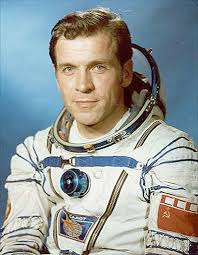Aleksandr Serebrov
Russian - (RFSA)
Deceased
Date of Birth: Feb. 15, 1944
Date of Death: Nov. 12, 2013
Aleksandr Aleksandrovich Serebrov (Russian: Алекса́ндр Алекса́ндрович Серебро́в, February 15, 1944 – November 12, 2013) was a Soviet cosmonaut. He graduated from Moscow Institute of Physics and Technology (1967), and was selected as a cosmonaut on December 1, 1978. He retired on May 10, 1995. He flew on Soyuz T-7, Soyuz T-8, Soyuz TM-8 and Soyuz TM-17. He was one of very few cosmonauts to fly for both the Soviet Union and the Russian Federation that followed it. He held the record for most spacewalks, 10, until Anatoly Solovyev surpassed it. In all, Serebrov spent 371.95 days in space. Serebrov contributed to the design of Salyut 6, Salyut 7, and the Mir space stations.
Soyuz-U | Soyuz T-5
Russian Federal Space Agency (ROSCOSMOS) | RussiaBaikonur Cosmodrome, Republic of Kazakhstan
May 13, 1982, 9:58 a.m.
Status: Success
Mission:
Soyuz T-5 was the first long-duration expedition to the Salyut 7 space station. The mission began on May 13, 1982, 09:58:05 UTC, launching Commander Anatoli Berezovoy and Flight Engineer Valentin Lebedev into orbit. They docked with the station the next day. During their 211-day stay on the station, crew performed various scientific and medical experiments, and were visited by 4 uncrewed cargo Progress vehicles and 2 Soyuz missions. Soyuz T-5 crew, per usual, swapped vehicles with the visiting Soyuz T-7 crew, which allowed for a longer stay in orbit. Cosmonauts returned in the Soyuz T-7 spacecraft, landing safely back on Earth on December 10, 1982, 19:02:36 UTC.
Low Earth OrbitSoyuz-U | Soyuz T-7
Russian Federal Space Agency (ROSCOSMOS) | RussiaBaikonur Cosmodrome, Republic of Kazakhstan
Aug. 19, 1982, 5:11 p.m.
Status: Success
Mission:
Soyuz T-7 was the third mission to the Salyut 7 space station and the second to visit the long-duration Soyuz T-5 resident crew of the station. The mission began on August 19, 1982, 17:11:52 UTC, launching Commander Leonid Popov, Flight Engineer Aleksandr Serebrov and Research Cosmonaut Svetlana Savitskaya, who was the second woman in space, 20 years after Valentina Tereshkova's flight. They docked with the station the next day. During their 7-day stay on the station, crew performed various scientific and medical experiments. Soyuz T-7, per usual, swapped their vehicles with the resident Soyuz T-5 crew, which allowed for a longer stay on the station. The crew returned in Soyuz T-5 spacecraft, landing safely back on Earth on August 27, 1982, 15:04:16 UTC.
Low Earth OrbitSoyuz-U | Soyuz T-8
Russian Federal Space Agency (ROSCOSMOS) | RussiaBaikonur Cosmodrome, Republic of Kazakhstan
April 20, 1983, 1:10 p.m.
Status: Success
Mission:
Soyuz T-8 was meant to be the fourth mission to visit the Salyut 7 space station. The mission began on April 20, 1983, 13:10:54 UTC, launching Commander Vladimir Titov, Flight Engineer Gennady Strekalov and Research Cosmonaut Aleksandr Serebrov into orbit. However, the spacecraft failed to dock with the space station and after some further attempts mission had to be aborted. The mission concluded two days later with a safe landing back on Earth on April 22, 1983, 13:28:42 UTC.
Low Earth OrbitSoyuz-U2 | Soyuz TM-8
Soviet Space Program | RussiaBaikonur Cosmodrome, Republic of Kazakhstan
Sept. 5, 1989, 9:38 p.m.
Status: Success
Mission:
Soyuz TM-8 was the eighth mission and the fifth long-duration expedition to Mir space station. The mission began on September 5, 1989, 21:38:03 UTC, launching Commander Alexander Viktorenko and Flight Engineer Aleksandr Serebrov into orbit. They docked with Mir two days later. During their stay there, cosmonauts performed five EVAs, various station maintenance tasks, and carried out scientific experiments in medicine, geophysics, space technology, earth observation, astronomy etc. The crew returned after 166 days in orbit, landing safely back on Earth on February 19, 1990, 04:36:18 UTC.
Low Earth OrbitSoyuz-U2 | Soyuz TM-17
Soviet Space Program | RussiaBaikonur Cosmodrome, Republic of Kazakhstan
July 1, 1993, 2:32 p.m.
Status: Success
Mission:
Soyuz TM-17 was the 17th mission and the 14th long-duration expedition to Mir space station. The mission began on July 1, 1993, 14:32:58 UTC, launching Commander Vasili Tsibliyev, Flight Engineer Aleksandr Serebrov and Research Cosmonaut Jean-Pierre Haigneré into orbit. They docked with Mir two days later. During their stay there, cosmonauts performed EVAs, various station repair and maintenance tasks, and carried out various scientific experiments. Station crew was visited by several Progress resupply spacecrafts, and welcomed aboard the Soyuz TM-18 crew. The mission concluded with a safe landing back on Earth on January 14, 1994, 08:18:20 UTC.
Low Earth OrbitThe Roscosmos State Corporation for Space Activities, commonly known as Roscosmos, is the governmental body responsible for the space science program of the Russian Federation and general aerospace research. Soyuz has many launch locations the Russian sites are Baikonur, Plesetsk and Vostochny however Ariane also purchases the vehicle and launches it from French Guiana.
Long March 7A
Shijian 29 A-B
201 - Wenchang Space Launch Site, People's Republic of China2 satellites officially described as for "demonstration of new technologies for spatial targets detection" purposes.
Long March 4B
Tianhui 7
Launch Area 94 (SLS-2 / 603) - Jiuquan Satellite Launch Center, People's Republic of ChinaA satellite officially described as for cartography purposes, details TBD.
Soyuz 2.1b/Fregat-M
AIST-2T 01 & 02
Cosmodrome Site 1S - Vostochny Cosmodrome, Siberia, Russian FederationA pair of Russian optical Earth observation satellites built by the Progress Rocket Space Centre for obtaining stereo images of the Earth's surface, …
Long March 3B/E
Fengyun-4C
Launch Complex 2 (LC-2) - Xichang Satellite Launch Center, People's Republic of ChinaChina's geostationary meteorological satellite program FY-4 (Feng Yun 4) is the second generation of chinese geostationary meteorological satellites.
Long March 8A
SatNet LEO Group 17
Commercial LC-1 - Wenchang Space Launch Site, People's Republic of ChinaA batch of 9 Low Earth Orbit communication satellites for the Chinese state owned SatNet constellation operated by the China Satellite Network Group.…




